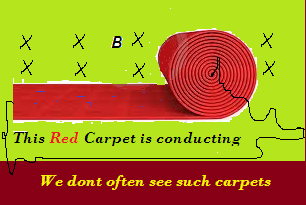The Red Conducting Carpet.
 A red carpet surprisingly found conducting has resistance
m
and total mass
M
and when rolled completely has radius
R
.
With a gentle negligible push it starts rolling on the ground with a velocity of
v
and radius
r
.
There exists a uniform magnetic field perpendicular to the base of the carpet the whole time. Let the whole motion stop after a time
T
.
The rms value of
v
r
during this time interval from
t
=
0
to
t
=
T
is
n
.
The centre is connected to the other end by a long wire of negligible resistance. Neglect any strain in the carpet. Then what is the value of
[
(
n
2
)
/
4
]
?
A red carpet surprisingly found conducting has resistance
m
and total mass
M
and when rolled completely has radius
R
.
With a gentle negligible push it starts rolling on the ground with a velocity of
v
and radius
r
.
There exists a uniform magnetic field perpendicular to the base of the carpet the whole time. Let the whole motion stop after a time
T
.
The rms value of
v
r
during this time interval from
t
=
0
to
t
=
T
is
n
.
The centre is connected to the other end by a long wire of negligible resistance. Neglect any strain in the carpet. Then what is the value of
[
(
n
2
)
/
4
]
?
Details and Assumptions
- T = 1 0 sec
- R = 5 m
- M = 2 kg
- m = 3 0 Ω
- g = 9 . 8 m/s 2
- B = π T
- [.] denotes the greatest integer function
The answer is 29.
This section requires Javascript.
You are seeing this because something didn't load right. We suggest you, (a) try
refreshing the page, (b) enabling javascript if it is disabled on your browser and,
finally, (c)
loading the
non-javascript version of this page
. We're sorry about the hassle.
2 solutions
Ah! I just realized that the answer is incorrect, as I didn't find root , hence, the correct answer would be ⌊ 2 B M m g R / T ⌋ = 2
Log in to reply
Thanks for pointing out i just made a correction
Well good solution , while preparing the problem , i thought flux calculation would create a good problem . but i didn't notice that we could do it directly. I had thought the presence of some small gaps between every roll in between would cause a problem.
Log in to reply
But there is no radial component of electric field , that is why even if there might be small gaps the no potential difference radially
Another method for finding induced emf could have been treating lowermost point as fixed and applying ϵ = 2 B ω r 2 = 2 B v r
let at some time t the velocity of the center of mass of the rolling part be v and radius be r. let there be p turns in the carpet per unit length.Let the current be then be I Let the total number of turns be n
ϕ = B . A = ∫ B π r 2 d N = ∫ 0 r B π r 2 p d r = 3 π B p r 3
d t d ϕ = π p B r 2 d t d r = m I
We know that the mass is constant
let the mass per unit length of carpet be ρ
ρ x + ρ ∫ 0 r 2 π r p d r = k
v = d t d x
− 2 π r p v = d t d r
i = − 2 m B v r
finally all the carpet is rolled out and velocity finally is 0 after t=Ts
applying energy conservation.
M g R = ∫ 0 t I 2 m d t = ∫ 0 t ( 2 m − B 2 v 2 r 2 ) 2 m d t
[ 4 ∫ 0 t d t ∫ 0 t v 2 r 2 d t ] = [ B 2 T M m g R ] = 2 9
Awesome problem!
Consider the line connecting the center of the rolled carpet and the bottom of the rolled carpet. Consider a point at a distance x below the center. Let velocity of center of mass be v and angular velocity ω = r v
The velocity of this point is : v − ω x
= v 0 − r v x
Now the emf produced(V) would be ∫ 0 r B ( v − r v x ) d x
= 2 B v r .
Using conservation of energy, loss in gravitational potential energy equals heat dissipation ,
⇒ M g R = ∫ 0 T m V 2 d t
⇒ M g R = ∫ 0 T 4 m B 2 ( v r ) 2 d t
⇒ ∫ 0 T ( v r ) 2 d t = B 2 4 M m g R
Hence, required rms value = n = T B 2 4 M m g R
Hence, ⌊ 4 n ⌋ = 2 9